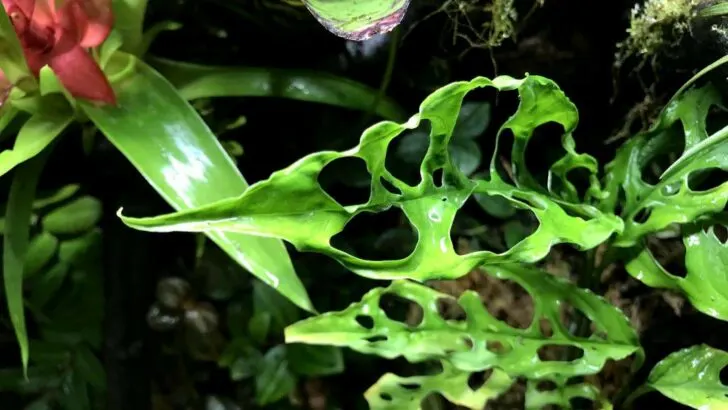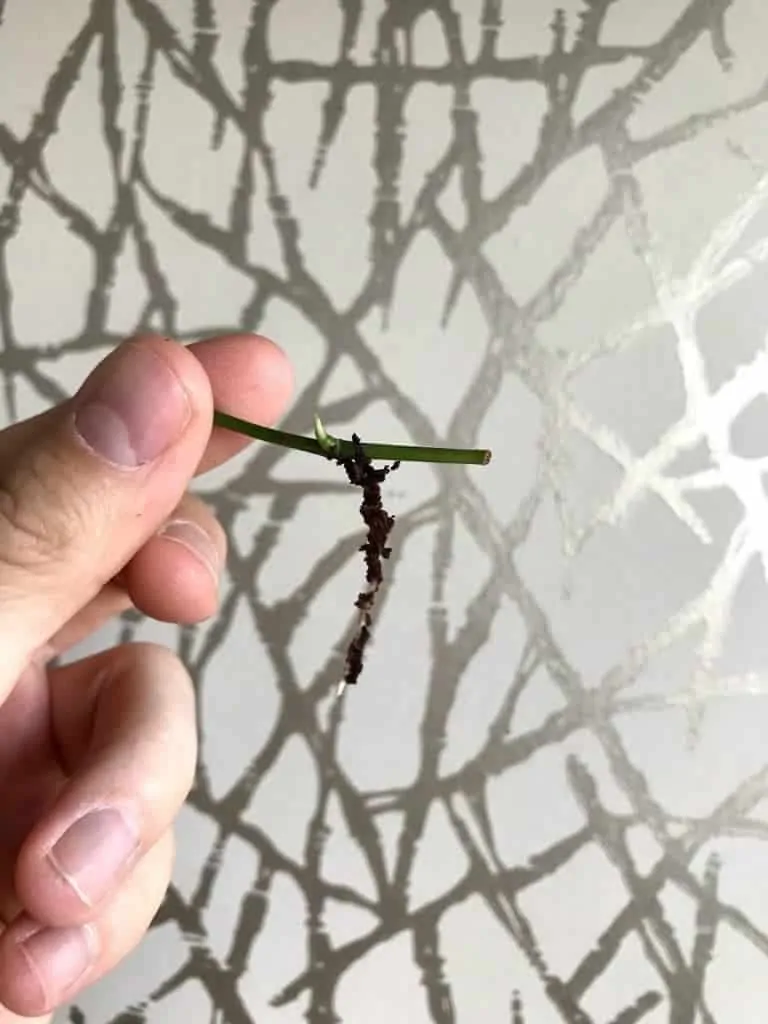Monstera obliqua is often confused with Monstera Adansonii.
Multiple plant shops, garden centers, and even plant enthusiasts use the name Obliqua for what is in 99.99% of the cases a Monstera Adansonii. It is not the same plant.
Both species are from the same genus called Monstera and belong to the Araceae family.
Monstera Adansonii is readily available in many plant shops and garden centers around the world whereas Monstera obliqua is rare.
Monstera obliqua Care
To care for Monstera obliqua provide it with high humidity of 80% and above. Best choose an enclosed environment such as a terrarium or a plastic box. For soil use a chunky aroid mix containing peat, perlite, coco coir, charcoal or use 100% sphagnum moss. Fertilize once a month with an N-P-K fertilizer of 20-20-20. Keep the daytime temperature around 25°C 77°F. Go easy on the light, especially for Monstera obliqua Peru. Bright indirect natural light is preferred to using grow lights.
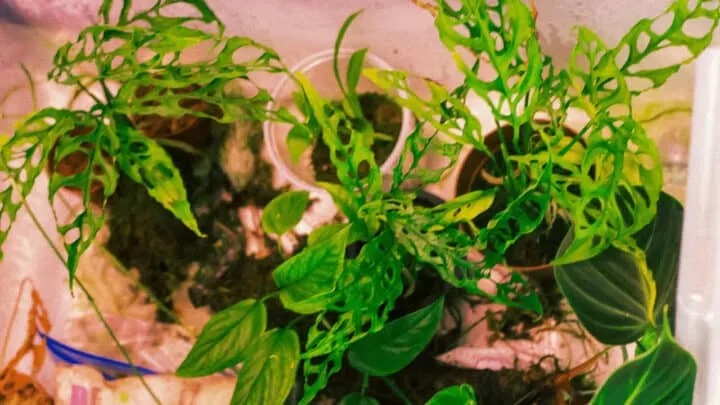
Monstera obliqua Peru and Brazil
The blog Muggle Plants, featuring one of the most respected articles on Monstera obliqua for the wider public states:
“There are only 17 known times in botanic history when Monstera obliqua was seen in the wild and leaves or other were collected for study. -Muggle Plants.”
As we know today, this no longer holds true or never was true.
At least not for Monstera obliqua per se as there are different Monstera obliqua plants from different regions and countries.
If this was mainly meant for Monstera obliqua Peru it might be correct.
However it is important to note that there are other obliquas that have been discovered such as:
- Monstera obliqua Bolivia
- Monstera obliqua Brazil
- Monstera obliqua Colombia
- Monstera obliqua Yasuni
- Monstera obliqua Amazonas
- Monstera obliqua French Guiana
- Monstera obliqua Tiwintiza
- Monstera obliqua Canelos
- Monstera cf. Obliqua Peru
- Monstera obliqua Peru
- Monstera Loreto Falcate
- Monstera obliqua Misahualli
- Monstera cf. Obliqua Napo
- Monstera obliqua Filamentous
- Monstera obliqua Loreto
- Monstera obliqua Tarapoa
according to @plandrew_
Table of Contents
The truth about your Monstera obliqua
The truth is, the Monstera obliqua you bought at the shop most likely has the wrong label.
The best way to check if you have a Monstera Adansonii or a Monstera obliqua is to answer these two questions:
Did I get the plant from a private collector?
Did I pay a very high 3- to 4-figure sum to acquire the plant?
If you can answer these two questions with a clear yes, the likelihood of either you have been scammed big time or having a real Monstera obliqua increases drastically.
If you answer any of these questions with a no, let’s face it, you have a Monstera Adansonii, a very beautiful plant nevertheless.
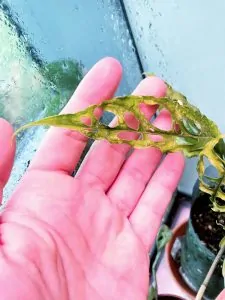
Monstera obliqua Peru
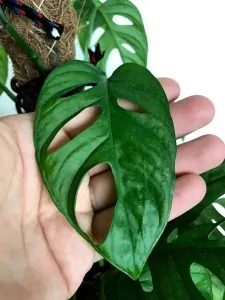
Monstera Adansonii
Let’s get to know Monstera obliqua better and look into its habitat, where it originates, how it looks like and how it grows starting by the habitat.
The blog post heavily relies on what Michael Madison wrote in his publication
“A revision of Monstera (Araceae)” in 1977 as well as on personal observations of keeping a Monstera obliqua in cultivation in vivarium conditions as well as on exchanges with other collectors calling themselves lucky enough to own this specimen.
Let’s start with the habitat where you are likely to find Monstera obliqua.
Habitat
Monstera obliqua inhabits an ephemeral, meaning fast-changing habitat, often at sea level and installs itself among roots on the lower section of larger trees.
It reaches maturity even on small trees as it is not a big climber. Its smallish size has the advantage that it can make use substrate that is not available to other plants.
Furthermore, it is epiphytic, meaning that it can grow on top of other plants and takes in moisture and nutrients from the air, from debris, rain and also water.
Geographic location
The geographic distribution reaches from Panama to Southern America. You find it in Costa Rica, Peru, and along the Amazon. Given the widespread geographical reason, isn’t it astonishing that this plant has only been seen very few times?
It is possible that it must be overlooked a lot as it is one of the smallest Monstera species if not the smallest. In the next section, we will have a look at how Monstera obliqua is growing.
The growth rate of Monstera obliqua
The Obliqua is an extremely slow grower.
This conclusion derives mostly from individual plant collectors that observe Monstera obliqua solely as a houseplant.
Furthermore, I can confirm the slow growth, specifically compared to its counterpart the Monstera Adansonii that seems to put out new leaves at a constant pace and overall growing vigorously.
In its natural habitat, the plant puts out between 30-70 new leaves for a time span between 12 to 18 months.
That is 2,5 leaves on the lower end, which I wouldn’t consider slow-growing at all.
What can we learn from this?
My conclusion would be that the better we can simulate the conditions of the habitat of the Monster Obliqua in terms of light, humidity, temperature, soil, and its general environment the better/faster it will grow.
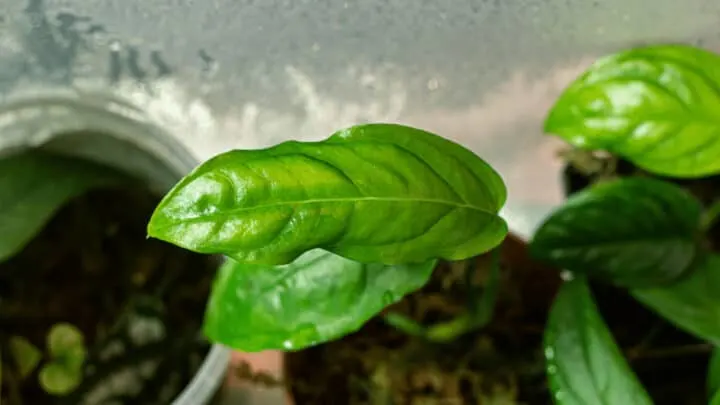
Monstera obliqua Amazonas
Personal observation in vivarium conditions
I observed my Monstera obliqua produce at least 1 leaf on average per month in vivarium conditions.
It is important to keep the humidity above 80% constantly.
Some people would even argue the having a humidity of above 90% works best for keeping an Obliqua healthy.
I provide 18 hours of artificial grow light and a minimum of 25°C 77°F daytime temperature.
One observation I made is that you need to be careful that you are not overdoing it with artificial grow lights.
The Monstera obliqua has very sensitive leaves and tends to yellow quite fast.
The leaves will not come back from that state but will yellow further, then eventually brown and fall off.
It is best to keep your Obliqua in semi-shade with either a window or a grow light nearby but not directly “shining” on the plant.
As a stark c0ntrast, in the typical living room conditions, they produce hardly any leaf and do not seem to grow well.
How Monstera obliqua looks like
The look of Monstera obliqua is highly variable.
It is a very small plant growing only a few meters high and you can describe it as a green climbing plant.
Each leaf in adult Monstera obliqua looks quite different and many don’t have any holes.
Only the Peruvian form features the starkly perforated holey leaves.
Therefore, it is a very delicate plant with much thinner leaves than Monstera Adansonii, where leaves feel leathery to the touch and the stems are rather delicate.
Let us now dive into the different aspects that best describe the look of a Monstera obliqua.
The Stem
The thickness of its stem is only around 2mm making the Obliqua the slimmest in the family.
In comparison stems of a mature Monstera deliciosa reach a stem thickness of up to 8cm.
The stem of Monstera obliqua is growing 2-5m a year in its natural habitat. Keeping it as a houseplant these numbers seem hard to believe.
In addition to the stem the Monstera obliqua produces stolons, these are leafless runners that drop to the forest floor and then grow horizontally until they find a new tree to grow on. Stolons can grow up to 20 meters in length.
The Leaves
When thinking about Monstera obliqua, people mostly think of very holey leaves and the famous hole to leaf ratio of 90%.
Leaves with a large number of holes is the feature of Obliqua found in Peru.
In other words, there are many more Obliqua types or species grouped together and observations show that 80% of these do only have slightly perforated leaves.
Most types have completely solid leaves. The leaves of Monstera obliqua reach a size of 10-25cm.
Leaf shape in itself is not a very reliable indicator to describe and differentiate Monstera obliqua.
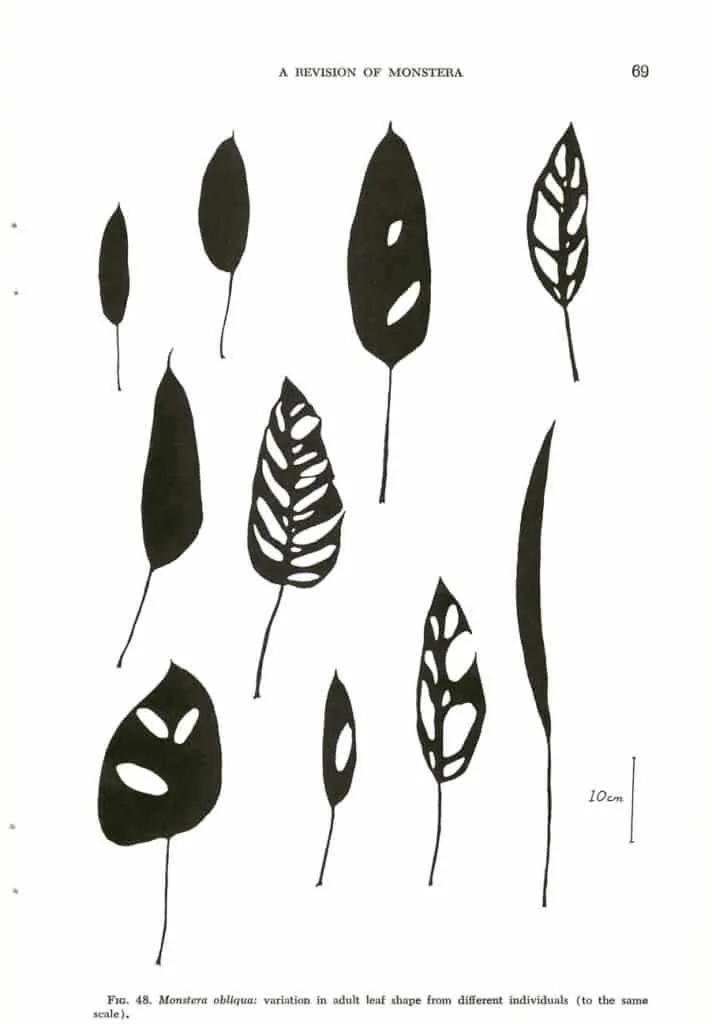
Monstera obliqua variations in adult leaf shapes (Credit: Michael Madison, A revision of Monstera (Araceae), 1977)
Flowering
Monstera, in general, seems not to have a specific flowering season. They can flower any month of the year.
When that happens, there are several inflorescences happening sequentially.
The inflorescence is a fancy term for flower. Monstera obliqua produces up to 8 spadices in a cluster whereas other Monstera in the family only produce 2.
Spadices or Spadix in the singular is a spike of minute flowers that are arranged closely around a fleshy axis enclosed in a spathe.
Monstera obliqua flowers 1.5 years after germination.
I do not think any plant enthusiast has ever witnessed an Obliqua flowering in his private collection but I might be wrong on this one.
The Fruit
The fruit of Monstera obliqua has a green spathe. The spadix initially turning into a greenish-white and then bright yellow colour.
After flowering, the colour of the spadix will change into a green colour again until becoming almost pale and turning into a deep orange in its final stage.
The fruits of Monstera obliqua seem to be unique. One reason being the orange globose berries that are free from one another. Other species arrange it tightly together.
The fruit is a great way to differentiate species from one another and shows you very distinct characteristics.
The challenge is, however, that you will rarely have an inflorescence or fruit available.
Propagation of Monstera obliqua Peru Form
I am happy to share some tips and tricks regarding the propagation of Monstera obliqua Peru form.
Although no one is known successfully propagating this plant in big numbers, there are at least two ways I identified that work to propagate the Monstera obliqua.
Propagating from the Stolon
The Monstera obliqua produces stolons from time to time. These are perfect for propagation.
Stolons itself look like stems.
They grow section by section, although hardly producing any leaves, each of these sections can be used for propagation.
Again there are multiple ways to do so. You can either try to root each section of the stolon while still attached to the mother plant.
Each of the nubs is able to produce roots and leaves. However, for this to work you will need a lot of humidity.
You can either put sphagnum moss or dirt directly on/under each of the nub sections. After 3 to 4 weeks you should see a root or even multiple roots to grow.
After the roots are rooted in your preferred medium you can start to cut off the different sections of the stolon and grow them further in spaghnum moss.
It is also possible to cut off the stolon sections earlier before they started to root.
It works as well but of course, the saver option is to wait for proper roots before cutting.
Then, once you have your rooted stolon sections you can put them into a growing medium. I use coco coir and have great success with it.
Keep the stolon section in a warm and very humid environment 90% – 99% humidity and you will soon see the roots, as well as the first leaf, growing. From there on you have a full plant, great success!
Propagating from cutting off a section of your Monstera obliqua
An alternative way is to propagate your Monstera obliqua by cutting off a section of your plant with preferably a leaf and always, it is impossible without, a node.
Nodes are these nubby things on your Monstera obliqua.
I would suggest that you also cut off a section where you have some roots / air roots growing that you produced by putting some sphagnum moss around your plant beforehand.
Let’s now jump into a section that highlights the Instagram Fame of Monstera obliqua.
Monstera obliqua and its Instagram Fame
Monstera obliqua is reaching Instagram fame as the hashtag #itsneverobliqua is taking off.
The hashtag was created by Mick Mittermeier (Instagram Account), an avid collector often asked to identify the real Obliqua.
Most if not all the “Monstera obliqua” have the wrong label. This tag has the ambition to correct that.
This phenomenon of wrongly labelled specimen is seen in brick and mortar stores and on the internet.
Private people share pictures and stories of their so-called Obliquas on the interwebs all day long showing pictures of what are Monstera Adansonii.
This article is an attempt to bring together information about the real Monstera obliqua and make it more accessible. Furthermore, it aggregates it with actual care information from people that have it in cultivation all around the world.
Source:
Michael Madison, A revision of Monstera (Araceae), 1977 https://www.aroid.org/genera/monstera/Madison_Monstera_Rec.pdf

Daniel has been a plant enthusiast for over 20 years. He owns hundreds of houseplants and prepares for the chili growing seasons yearly with great anticipation. His favorite plants are plant species in the Araceae family, such as Monstera, Philodendron, and Anthurium. He also loves gardening and is growing hot peppers, tomatoes, and many more vegetables.

